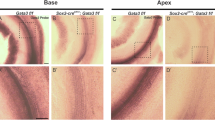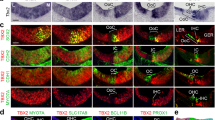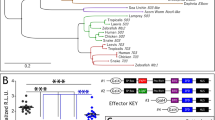Abstract
Fkh10 is a member of the forkhead family of winged helix transcriptional regulators. Genes encoding forkhead proteins are instrumental during embryogenesis in mammals, in particular during development of the nervous system 1, 2, 3, 4, 5 . Here we report that mice with a targeted disruption of the Fkh10 locus exhibit circling behaviour, poor swimming ability and abnormal reaching response—all common findings in mice with vestibular dysfunction 6 . These animals also fail to elicit a Preyer reflex in response to a suprathreshold auditory stimulation, as seen in mice with profound hearing impairment 7, 8 . Histological examination of the inner ear reveals a gross structural malformation of the vestibulum as well as the cochlea. These structures have been replaced by a single irregular cavity in which neither proper semicircular ducts nor cochlea can be identified. We also show that at 9.5 days post coitum (dpc), Fkh10 is exclusively expressed in the otic vesicle. These findings implicate Fkh10 as an early regulator necessary for development of both cochlea and vestibulum and identify its human homologue FKHL10 as a previously unknown candidate deafness gene at 5q34.
This is a preview of subscription content, access via your institution
Access options
Subscribe to this journal
Receive 12 print issues and online access
$209.00 per year
only $17.42 per issue
Buy this article
- Purchase on Springer Link
- Instant access to full article PDF
Prices may be subject to local taxes which are calculated during checkout



Similar content being viewed by others
Accession codes
References
Ang, S. L & Rossant, J. HNF-3β is essential for node and notochord formation in mouse development. Cell 78, 561–574 (1994).
Sasaki, H. & Hogan, B.L. HNF-3β as a regulator of floor plate development. Cell 76, 103– 115 (1994).
Weinstein, D.C. et al. The winged helix transcription factor HNF-3β is required for notochord development in the mouse embryo. Cell 78, 575–588 (1994).
Xuan, S. et al. Winged helix transcription factor BF-1 is essential for the development of the cerebral hemispheres. Neuron 14, 1141–1152 (1995).
LaBosky, P.A. et al. The winged helix gene Mf3, is required for normal development of the diencephalon and midbrain, postnatal growth and the milk-ejection reflex. Development 124, 1263– 1274 (1997).
Lyon, M.F., Rastan, S. & Brown, S.D.M. Genetic Variants and Strains of the Laboratory Mouse (Oxford University Press, Oxford, 1996).
Steel, K.P. & Bock, G.R. Cochlear dysfunction in the Jerker mouse. Behav. Neurosci. 3, 381– 391 (1983).
Steel, K.P. & Harvey, D. Development of the auditory function in mutant mice. in Development of Auditory and Vestibular System 2 (ed. Romand, R.) 221–242 (Elsevier Science Publishers, Amsterdam, 1992).
Gibson, F. et al. A type VII myosin encoded by the mouse deafness gene shaker-1 . Nature 374, 62–64 (1995).
Weil, D. et al. Defective myosin VIIA gene responsible for Usher syndrome type 1B. Nature 374, 60–61 (1995).
Probst, F.J. et al. Correction of deafness in shaker-2 mice by an unconventional myosin in a BAC transgene. Science 280, 1444–1447 (1998).
Wang, A. et al. Association of unconventional myosin MYO15 mutations with human nonsyndromic deafness DFNB3. Science 280 , 1447–1451 (1998).
Epstein, D.J., Vekemans, M. & Gross, P. Splotch (Sp2H), a mutation affecting development of the mouse neural tube, shows a deletion within the paired homeodomain of Pax-3. Cell 67, 767–774 (1991).
Tassabehji, M. et al. Waardenburg syndrome patients have mutations in the human homologue of the Pax-3 paired box gene. Nature 355, 635–636 (1992).
Erkman, L. et al. Role of transcription factors Brn-3.1 and Brn-3.2 in auditory and visual system development. Nature 381, 603–606 (1996).
Hadrys, T., Braun, T., Rinkwitz-Brandt, S., Arnold, H.-H. & Bober, E. Nkx5-1 controls semicircular canal formation in the mouse inner ear. Development 125, 33–39 (1998).
Wang, W., Van De Water, T. & Lufkin, T. Inner ear and maternal defects in mice lacking the Hmx3 homeobox gene. Development 125, 621–634 (1998).
Torres, M. & Giráldez, F. The development of the vertebrate inner ear. Mech. Dev. 71, 5– 21 (1998).
Cordes, S.P. & Barsh, G.S. The mouse segmentation gene kr encodes a novel basic domain-leucine zipper transcription factor. Cell 79, 1025–1034 ( 1994).
Deol, M.S. The abnormalities of the inner ear in kreisler mice. J. Embryol. Exp. Morph. 12, 475–490 (1964).
Frohman, M., Martin, G.R., Cordes, S.P., Halamek, L. & Barsh, G.S. Altered rhombomere-specific gene expression and hyoid bone differentiation in the mouse segmentation mutant, kreisler (kr). Development 117, 925– 936 (1993).
McKay, I.J. et al. The kreisler mouse: a hindbrain segmentation mutant that lacks two rhombomeres. Development 120, 2199– 2211 (1994).
Mark, M. et al. Two rhombomeres are altered in Hoxa-1 mutant mice. Development 119, 319–338 (1993).
Larsson, C. et al. Chromosomal localization of six human forkhead genes, freac-1 (FKHL5), -3 (FKHL7), -4 (FKHL8), -5 (FKHL9), -6 (FKHL10) and -8 (FKHL12). Genomics 30, 464– 469 (1995).
Pierrou, S., Hellqvist, M., Samuelsson, L., Enerback, S. & Carlsson, P. Cloning and characterization of seven human forkhead proteins: binding site specificity and DNA bending. EMBO J. 13, 5002–5012 ( 1994).
Clevidence, D.E. et al. Identification of nine tissue-specific transcription factors of the hepatocyte nuclear factor 3/forkhead DNA-binding-domain family. Proc. Natl Acad. Sci. USA 90, 3948– 3952 (1993).
Overdier, D.G., Ye, H., Peterson, R.S., Clevidence, D.E. & Costa., R.H. The winged helix transcriptional activator HFH-3 is expressed in the distal tubulus of embryonic and adult mouse kidney. J. Biol. Chem. 272, 13725–13730 (1997).
Steel, K.P. & Bock, G.R. Hereditary inner-ear abnormalities in animals. Arch. Otolaryngol. 109, 22– 29 (1983).
Tybulewicz, V.L.J., Crawford, C.E., Jackson, P.K., Bronson, R.T. & Mulligan, R.C. Neonatal lethality and lymphopenia in mice with a homozygous disruption of the c-abl proto-oncogene. Cell 65, 1153–1163 ( 1991).
Rosen, B. & Beddington, R.S.P. Whole mount in situ hybridization in the mouse embryo: gene expression in three dimensions. Trends Genet. 9, 162–167 (1993).
Acknowledgements
We thank A. Gossler, K.R. Johnson and L.P. Kozak for valuable discussion and A. Lindahl for help in analysing serum samples. This work was made possible with support from the Swedish Medical Research Council, The Lundberg Foundation, The Juvenile Diabetes Foundation, a Junior Individual Grant from The Swedish Foundation for Strategic Research to S.E. and an EMBO short term fellowship to M.H.
Author information
Authors and Affiliations
Corresponding author
Rights and permissions
About this article
Cite this article
Hulander, M., Wurst, W., Carlsson, P. et al. The winged helix transcription factor Fkh10 is required for normal development of the inner ear. Nat Genet 20, 374–376 (1998). https://doi.org/10.1038/3850
Received:
Accepted:
Issue Date:
DOI: https://doi.org/10.1038/3850
This article is cited by
-
Homozygous Missense Variants in FOXI1 and TMPRSS3 Genes Associated with Non-syndromic Deafness in Moroccan Families
Biochemical Genetics (2023)
-
Gene therapy development in hearing research in China
Gene Therapy (2020)
-
Foxi3 transcription factor activity is mediated by a C-terminal transactivation domain and regulated by the Protein Phosphatase 2A (PP2A) complex
Scientific Reports (2018)
-
The role of FOXP3 in the development and metastatic spread of breast cancer
Cancer and Metastasis Reviews (2012)
-
A symphony of inner ear developmental control genes
BMC Genetics (2010)



